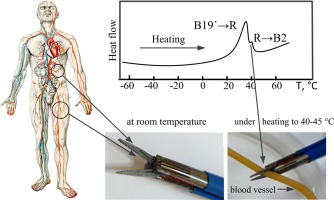当前位置:
X-MOL 学术
›
Mater. Des.
›
论文详情
Our official English website, www.x-mol.net, welcomes your
feedback! (Note: you will need to create a separate account there.)
Control of phase transformations and microstructure for optimum realization of one-way and two-way shape memory effects in removable surgical clips
Materials & Design ( IF 7.6 ) Pub Date : 2017-12-01 , DOI: 10.1016/j.matdes.2017.09.024 E. Ryklina , A. Korotitskiy , I. Khmelevskaya , S. Prokoshkin , K. Polyakova , A. Kolobova , M. Soutorine , A. Chernov
Materials & Design ( IF 7.6 ) Pub Date : 2017-12-01 , DOI: 10.1016/j.matdes.2017.09.024 E. Ryklina , A. Korotitskiy , I. Khmelevskaya , S. Prokoshkin , K. Polyakova , A. Kolobova , M. Soutorine , A. Chernov

|
Abstract The functioning of a newly developed “smart” clip for permanent or temporary clipping of the blood vessels is based on one-way and two-way shape memory effects (SME and TWSME, respectively) of Ti-Ni alloy. The clip remains in the ready-to-close position before it is locally heated up to 40–45 °C. Once heated by a specially developed clip-holder device, it closes due to realization of the SME, thus softly clipping the vessel. Upon local cooling, the clip opens due to the TWSME realization and can be easily removed without trauma to the vessel. To solve the problem of realization of SME and TWSME in the required temperature ranges and with the best functional characteristics, a thermomechanical treatment of Ti-50.7 at.%Ni alloy for controlled precipitation of Ti3Ni4 phase particles and subsequent martensitic transformations was developed. A special regime of the clip thermomechanical treatment, including hot rolling and post-deformation isothermal annealing (aging), SME training procedures, and special design of the clip, was developed to obtain the best combination of the recovery strain and recovery stress of the clip. The phase transformations and microstructure were studied using differential scanning calorimetry, X-ray diffractometry, and transmission electron microscopy. The functional properties of the clips were determined using a bending method for inducing strain. The bench tests of the clip confirmed the effectiveness of the optimized thermomechanical treatment and training regimes as well as the cross-shaped clip design.
中文翻译:

控制相变和微观结构,以在可拆卸手术夹中最佳实现单向和双向形状记忆效应
摘要 新开发的用于永久或临时夹闭血管的“智能”夹的功能基于 Ti-Ni 合金的单向和双向形状记忆效应(分别为 SME 和 TWSME)。在局部加热到 40–45 °C 之前,夹子保持在准备关闭的位置。一旦由专门开发的夹子固定装置加热,它就会由于 SME 的实现而关闭,从而轻柔地夹住容器。在局部冷却时,夹子由于 TWSME 的实现而打开,并且可以轻松移除而不会对血管造成创伤。为了解决在所需温度范围内实现 SME 和 TWSME 并具有最佳功能特性的问题,开发了一种对 Ti-50.7 at.%Ni 合金进行热机械处理,以控制 Ti3Ni4 相颗粒的析出和随后的马氏体转变。开发了一种特殊的夹子热机械处理方案,包括热轧和变形后等温退火(时效)、SME 培训程序和夹子的特殊设计,以获得夹子的恢复应变和恢复应力的最佳组合. 使用差示扫描量热法、X 射线衍射法和透射电子显微镜研究相变和微观结构。夹子的功能特性是使用弯曲方法确定的,以引起应变。夹子的台架测试证实了优化的热机械治疗和训练方案以及十字形夹子设计的有效性。和特殊设计的夹子,旨在获得夹子的恢复应变和恢复应力的最佳组合。使用差示扫描量热法、X 射线衍射法和透射电子显微镜研究相变和微观结构。夹子的功能特性是使用弯曲方法确定的,以引起应变。夹子的台架测试证实了优化的热机械治疗和训练方案以及十字形夹子设计的有效性。和特殊设计的夹子,旨在获得夹子的恢复应变和恢复应力的最佳组合。使用差示扫描量热法、X 射线衍射法和透射电子显微镜研究相变和微观结构。夹子的功能特性是使用弯曲方法确定的,以引起应变。夹子的台架测试证实了优化的热机械治疗和训练方案以及十字形夹子设计的有效性。夹子的功能特性是使用弯曲方法确定的,以引起应变。夹子的台架测试证实了优化的热机械治疗和训练方案以及十字形夹子设计的有效性。夹子的功能特性是使用弯曲方法确定的,以引起应变。夹子的台架测试证实了优化的热机械治疗和训练方案以及十字形夹子设计的有效性。
更新日期:2017-12-01
中文翻译:

控制相变和微观结构,以在可拆卸手术夹中最佳实现单向和双向形状记忆效应
摘要 新开发的用于永久或临时夹闭血管的“智能”夹的功能基于 Ti-Ni 合金的单向和双向形状记忆效应(分别为 SME 和 TWSME)。在局部加热到 40–45 °C 之前,夹子保持在准备关闭的位置。一旦由专门开发的夹子固定装置加热,它就会由于 SME 的实现而关闭,从而轻柔地夹住容器。在局部冷却时,夹子由于 TWSME 的实现而打开,并且可以轻松移除而不会对血管造成创伤。为了解决在所需温度范围内实现 SME 和 TWSME 并具有最佳功能特性的问题,开发了一种对 Ti-50.7 at.%Ni 合金进行热机械处理,以控制 Ti3Ni4 相颗粒的析出和随后的马氏体转变。开发了一种特殊的夹子热机械处理方案,包括热轧和变形后等温退火(时效)、SME 培训程序和夹子的特殊设计,以获得夹子的恢复应变和恢复应力的最佳组合. 使用差示扫描量热法、X 射线衍射法和透射电子显微镜研究相变和微观结构。夹子的功能特性是使用弯曲方法确定的,以引起应变。夹子的台架测试证实了优化的热机械治疗和训练方案以及十字形夹子设计的有效性。和特殊设计的夹子,旨在获得夹子的恢复应变和恢复应力的最佳组合。使用差示扫描量热法、X 射线衍射法和透射电子显微镜研究相变和微观结构。夹子的功能特性是使用弯曲方法确定的,以引起应变。夹子的台架测试证实了优化的热机械治疗和训练方案以及十字形夹子设计的有效性。和特殊设计的夹子,旨在获得夹子的恢复应变和恢复应力的最佳组合。使用差示扫描量热法、X 射线衍射法和透射电子显微镜研究相变和微观结构。夹子的功能特性是使用弯曲方法确定的,以引起应变。夹子的台架测试证实了优化的热机械治疗和训练方案以及十字形夹子设计的有效性。夹子的功能特性是使用弯曲方法确定的,以引起应变。夹子的台架测试证实了优化的热机械治疗和训练方案以及十字形夹子设计的有效性。夹子的功能特性是使用弯曲方法确定的,以引起应变。夹子的台架测试证实了优化的热机械治疗和训练方案以及十字形夹子设计的有效性。











































 京公网安备 11010802027423号
京公网安备 11010802027423号